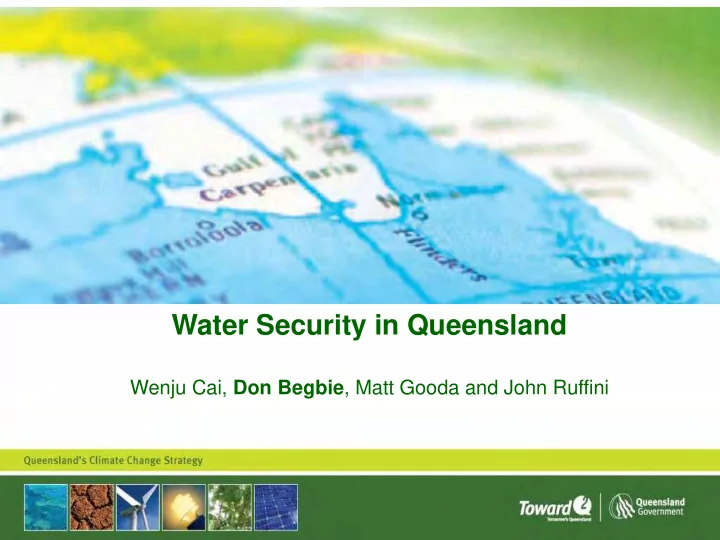

Water Security in Queensland Wenju Cai, Don Begbie , Matt Gooda and John Ruffini
Presentation Outline • Context in SEQ • Climate change and variability – impact on rainfall in SEQ • Downscaled climate modelling – drought projections • Impact on hydrology and dam inflows • Concluding remarks
Combined dam capacity Wivenhoe, Somerset and North Pine “Crikey!!” “Crikey!”
Projection: SEQ water demand & supply
Long-term water security Simulated SEQ water storage level (1890-2009) Are we here? Or here? Source: SEQ Water Strategy. Simulated SEQ Water Grid levels based on historic inflows and operation at LOS system yield.
Research Questions … 1. What causes drought in the SEQ region, and how the intensity, duration and frequency of drought may change in a warming climate , in addition to forcing by multidecadal variability. (in conjunction with Qld Climate Change Centre of Excellence) 2. How best to translate global projections of climate change (rainfall and other hydrological fields) into future water availability information. (in collaboration with Department of Environment and Resource Management) 3. How sensitive to the resolution of climate information is the SEQ stream-flow model IQQM (Integrated Quantity and Quality Model). (in collaboration with Department of Environment and Resource Management)
Downscaled drought projections Palmer Drought Severity Index – Simple water balance model, proxy to soil moisture conditions – Driven by monthly rainfall, temperature – Modified to use the downscaled potential evaporation data instead of deriving an approximation from rainfall and temperature – Index with range of around -6 (severe water deficiency) to +6 (anomalously wet) – Calibrated against 1971-2000 as ‘normal’ conditions
Downscaling experiments completed to date • CSIRO-MK3.0 A1B • CSIRO-MK3.0 A2 • CSIRO-MK3.5 A2 • GFDL CM2.1 A2 • MIROC3.2 MEDRES A2 • MPI/ECHAM5 A2 • UKMO-Hadcm3 A2 • NCAR-CCSM3.0 A2 • UKMO-HadGEM1 A2
Downscaled drought projections (2010-2100)
Projected percent time and duration in drought Percent time in drought Mean drought duration 80.00 140 70.00 120 60.00 100 onths) csiro_mk3_0 csiro_mk3_0 50.00 csiro_mk3_0 csiro_mk3_0 ean duration (m 80 e csiro_mk3_5 % tim csiro_mk3_5 40.00 gfdl_cm2_1 gfdl_cm2_1 60 miroc3_2_medres miroc3_2_medres 30.00 mpi_echam5 mpi_echam5 M 40 20.00 20 10.00 0.00 0 1990 2032 2078 1990 2032 2078 Centre of time period Centre of time period • Large inter-model uncertainty • Uncertainty increases with time • All agree on increased proportion of time in drought • All agree on increased duration of drought
Climate impacts on hydrology – Using downscaled climate model outputs to force Integrated Quantity and Quality Model (IQQM) – Focusing on Wivenhoe catchment in SEQ region
Projected change by 2050 under median climate sensitivity Downscaled from CSIRO Mk3.5 Rainfall % change Potential Evaporation % change
Percent Rainfall Change for 2050 Downscaling results in both temporal and spatial variation from the original GCM climate change impacts
Using those % changes for 2050 and downscaling effects on hydrologic model inputs
Modelled storage behaviour
Consensus • El Niño and La Niña cycle is the rain-generating mechanism for SEQ. • The rainfall reduction since 1980 is mainly due to a breakdown of ENSO associated with decadal variability dominated by the Inter-decadal Pacific Oscillation – Climate change may not be the main driver. • There is not yet a consensus in the models as to the direction of future rainfall changes over SEQ. – Recent weather events primarily reflect natural climate variability but the magnitude of such events over the longer term may increase with climate change. • Impact of rising temperature may be significant – Good agreement on increased frequency and duration of drought and increased evaporation. • Downscaling analyses to date shows that climate change assessments using Global Climate Models may underestimate the impact on available water resources in SEQ – Likely impact on reduced inflows to dams and increased time between filling events.
Future research • Completion of a super-high resolution (~8km) downscaling experiment. • Analysis of response of drought (intensity, frequency and duration) to climate change. • Sensitivity of SEQ IQQM to downscaled climate forcing data. – Examine impact of increased evaporation on inflows assuming rainfall remains constant.
Urban Water Security Research Alliance www.urbanwateralliance.org.au
Recommend
More recommend